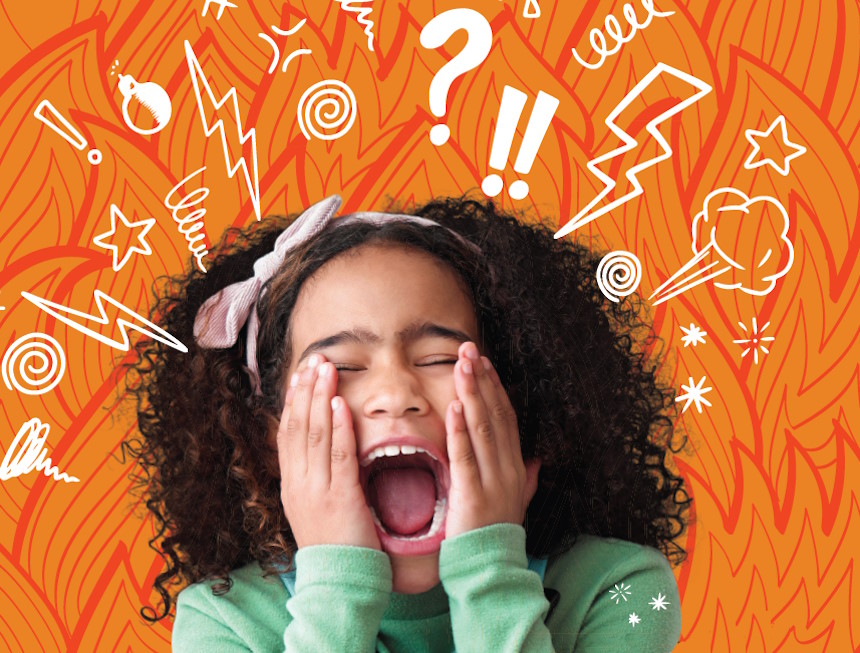From Meltdowns to Calm
“Why is it such a battle when we ask our son to get ready for bed? It can take an hour just to get past the meltdown and get him to his room!”
“If she can’t do something she wants to do, it becomes a major crisis!”
“When she’s tired or hungry, you’d best stay out of her way. You do not want to be around her.”
Emotional dysregulation is increasingly recognized as a challenge for many children and teens with ADHD. No longer considered just bad behavior, it’s clear that staying in control can be a struggle for youth with ADHD despite their best intentions. And when kids are dysregulated, families are often thrown into chaos. Parents describe “walking on eggshells” in their efforts to manage the behaviors and find some moments of calm in their daily lives.

“When she’s tired or hungry, you’d best stay out of her way. You do not want to be around her.”
So, how can we help youth to build better emotional regulation? Before considering what you can do, it helps to know a bit about what the term means and what factors contribute to the development of good regulation.
Emotional Regulation = the ability to be thoughtful, flexible, and intentional about how we respond to our own feeling
Emotional regulation is a process that allows us to take our own “emotional temperature” and make well-reasoned choices about how we want to respond to our feelings. Good emotional regulation allows us to keep our behavior within an acceptable range so that we can meet the expectations and goals that are important to us.
In contrast, when emotional regulation is a challenge, kids’ feelings and behavior often seem out of control. When kids or teens regularly respond to everyday difficulties of life with emotional meltdowns or out-of-control behavior, we say that they are dysregulated.
Emotional regulation and executive functioning
We know that children and teens with ADHD most often struggle with executive functioning, the processes involving mental control and goal-directed behavior. What are some ways that executive functioning is linked to emotional regulation?

“If she can’t do something she wants to do, it becomes a major crisis!”
When something happens that triggers strong feelings, we have to press the pause button before we respond. This allows for a small cushion of time to think about what sets us off and to consider expectations, rules, and personal goals. We scroll through options for how to proceed and consider the likely outcome of each one. Finally, we choose the option that is most likely to meet our needs, and we decide how and when to carry through with it. All of this requires flexibility, good working memory, the ability to monitor our own feelings and behavior, and well-developed planning and organization skills.
What else do we know about building emotional regulation skills?
Executive functioning is not the only important consideration when we look at how to build better emotional regulation. It also helps to understand two other crucial ingredients, managing physiological arousal, and emotional literacy. Let’s look at each of these briefly.
Physiological arousal is a term for what happens when our bodies become stimulated, and we are on alert. Research shows that some people are more easily stimulated than others. Stimulation can come from our emotions (“I’m mad!” or “I’m worried.”), from our sensory system (“They’re making too much noise!”) or from our physical state (“I’m tired and hungry!”). All of these go into the same “arousal bucket,” adding to the risk of having our feelings overflow their container and getting out of control. For example, if we are tired, then we are more likely to lose control when something happens that is emotionally challenging. Those who tend to be easily stimulated can quickly fill their buckets, and they are prone to difficulties with emotional regulation.

“Why is it such a battle when we ask our son to get ready for bed? It can take an hour just to get past the meltdown and get him to his room!”
There’s yet another critical link between physiological arousal and children’s emotional regulation. We have compelling evidence that when parents’ arousal level is high during interactions with their child, then the child’s level of arousal increases, too. The challenges of raising a child with executive functioning weaknesses can lead even the calmest of parents to lose their cool on occasion. When this happens repeatedly, our kids’ development suffers.
One researcher summarized the results of studies on family interactions and long-term development of children with ADHD. “Harsh, critical, and highly emotional parenting causes strong physiological (physical) reactions in the bodies of both parents and children. These reactions can be measured in a number of ways, including rapid heart rate responses during parent-child interactions. When parents are harsh, highly emotional, and critical, their children’s bodies react as if a major threat has occurred.” (Beauchaine, 2020.) In other words, parents can contribute to overfilling their children’s arousal buckets when their own reactions are not well-regulated.
But there is hope here, too. The same researcher studied treatment aimed at increasing positive interactions within the family and helping parents to regulate their own emotions in response to their children. The good news? He found that when parents reduced their own “negative parenting behaviors,” their children were calmer, and their behavior improved.
Finally, the other element of emotional regulation that is important for you to know about is emotional literacy. Emotional literacy is simply the ability to use words to label our feelings. Brain imaging studies show that when children (and adults!) label their feelings, activity in the parts of the brain responsible for automatic emotional reactions quiets down. (See Lieberman et al., 2011, for a summary of the research). We experience less distress over difficult situations, so we are better able to keep our feelings and behavior within an acceptable range. It’s important to know that naming our feelings is different from reimagining and rehashing a situation endlessly. In fact, that can be a problem for self-regulation. However, labeling our feelings helps us to better control our behavior. You may have heard the phrase, “Name it to tame it.” It applies here.

Particularly with young children, soothing is most often an interactive process. Dysregulated kids often need a regulation partner well past their early years.
So, how can we help?
Below are some general guidelines for helping youth with emotional regulation. Perhaps the examples of how to apply these guidelines will help you to move toward calmness in your home.
- Focus on calm interactions and teach children ways to calm themselves.
- Practice responding to strong emotion with a quieter voice than your child. Loud voices increase our own and others’ arousal level. Speaking softly calms things down. If you’re thinking, “But my child won’t hear me when he’s shouting!” then try this. When your child is yelling, say softly “There is candy in the top drawer of my desk if you’d like some.” You might be surprised to find that your child heads right over to your desk! Be sure you’ve added a favorite candy in advance.
- Walk away if you’re too upset to interact thoughtfully.
- Particularly with young children, soothing is most often an interactive process. Dysregulated kids often need a regulation partner well past their early years. Find what works for your child and do it together. (“Hey, buddy. Let’s go outside and look for lightning bugs.” “Breathe with me. Let’s go for ten deep breaths.”)
- Go outdoors. Nature is a proven strategy for calming (and for restoring executive functioning).
- Exercise is another proven strategy that suits many kids and teens (and adults). One child we knew balked at breathing exercises and instead ran up and down the steps of her three-story home when she was upset.
- Teach emotional literacy, the ability to identify and label the full variety of feelings.
- Be a mirror for what you see. “Whoa! That’s an angry looking face. What happened?”
- Model that all feelings are acceptable, though not all behaviors are okay. We sometimes fall into the trap of rejecting our kids’ feelings because they make us uncomfortable or because we take them personally. For example, dysregulated kids often shout things like, “You’re a terrible mom. I hate you!” In response, we might say, “After all I’ve done for you, you have no right to be angry!” Instead, re-focus yourself and your child on the feeling and the source of the problem. “I get it that you’re upset because I said that you can’t go to Sam’s house now. I need you to stop shouting and then we can talk about a better time to go.”
- Talk about your own emotions. “I’m having a lousy day today. I’m angry and I’m tired. This is just not a good day.”
- Use proactive strategies to build positive behaviors.
- Set up clear rules and expectations. Post a list of house rules. Be generous with your praise when your child demonstrates any of these behaviors.
- Create a systematic behavior management plan that identifies goal behaviors in very specific and measurable terms. For example, “Start homework at 4:00.” “Set table for dinner by 5:50 pm.” “Play quietly during sister’s nap time.” Track daily success. Consider your child or teen’s own preferences to develop a menu of rewards for points earned for each goal. (For step-by-step guidelines for building a good behavior management system, see Barkley and Benton, 2013.)
- Plan ahead for possible trouble spots. “Mallory, this dance recital is going to be all about your sister. I know that the performances can run long, but I expect you to sit with us for the whole time. You can listen to your own music if you use your earbuds, so you don’t disturb anybody.”
- Intervene before the problem gets overwhelming.
- Learn the signs of escalating arousal levels in your child and initiate calming strategies. We all have “tells” that show we’re having trouble managing our emotions. For some, it’s a tone of voice. For others, it’s a facial expression or the hissing sound we make as we harshly blow air out through billowed cheeks. What are your tells? What are your child’s?
- Help your child to put their feelings into context by linking them to the trigger. (“You seemed to get upset when I said it was time to clean your room. How can I help?”)
- For a straightforward model, follow this five-step plan when your child seems at risk of losing control.
- Give words to the child’s feelings. (“You seem really upset/angry/worried.”)
- Ask brief questions to understand, and then listen. (“What’s going on? What happened?”)
- Offer understanding and put the feelings into context. (“Yeah. I don’t like it when people tell me what to do either.”)
- Set a clear limit. Don’t use a lot of words here. (“But sometimes, there are rules to follow. And in our house, electronics go off at 8:00.”)
- FYI: You can negotiate if the child makes a reasonable request. (“Okay. Maybe we can change the cutoff time to 8:30 now that you’re older. I’ll think about it and get back to you tomorrow.”)
- Introduce strategies that help children to monitor their feelings and to put them into perspective. These can be used at home or in a classroom. “The Incredible 5 Point Scale” offers guidelines and visual supports to teach kids about self-regulation. (Buron and Curtis, 2021) “Zones of Regulation” is designed to help children learn to recognize their own feelings, assess their level of arousal, and adjust their arousal to what’s needed for the situation. (Kuypers, 2011)
- Give children time and space to process their feelings.
- Give your child a heads-up to prepare for being upset. “Ella, I know that this may be hard for you, so take a deep breath. Great. Now, we will not be able to go to a movie today after all. I hope we can go tomorrow instead.”
- The more intense your child’s meltdown, the more time you will need to allow time for their arousal level to diminish. A full-on, intense fight-or-flight episode triggers a complex cascade of changes in the body. During this time, the body is primed for action rather than reflection. Focus on using a calm voice and only a few words. Offer choices. If you can do so safely, leave the room. If not, back away to give your child physical space. Wait quietly.
 You need to know that improvements in emotional regulation happen gradually. Make a plan and stick with it, looking for small signs such as more flexible problem-solving, better ability to respond to your suggestions when upset, or fewer and less intense meltdowns over time. If your child continues to be dysregulated despite these strategies or if there are frequent episodes of threatening or dangerous behavior, then it is time to seek the help of a mental health clinician or behavioral specialist. These professionals can help you to assess the factors that can lead a child to be dysregulated, create a plan for how to help, and design a crisis plan, if needed.
You need to know that improvements in emotional regulation happen gradually. Make a plan and stick with it, looking for small signs such as more flexible problem-solving, better ability to respond to your suggestions when upset, or fewer and less intense meltdowns over time. If your child continues to be dysregulated despite these strategies or if there are frequent episodes of threatening or dangerous behavior, then it is time to seek the help of a mental health clinician or behavioral specialist. These professionals can help you to assess the factors that can lead a child to be dysregulated, create a plan for how to help, and design a crisis plan, if needed.


 Joyce Cooper-Kahn, PhD, is a clinical child psychologist who specializes in the treatment of children and adolescents with ADHD, executive functioning challenges, and other learning disabilities. For over thirty years, she has focused on helping children, their families, and schools manage developmental challenges. Dr. Cooper-Kahn is a member of the editorial advisory board of CHADD’s Attention magazine. This article is excerpted from her upcoming book Late, Lost and Unprepared: A Parent’s Guide to Helping Children with Executive Functioning, second edition (J. Cooper-Kahn and L. Dietzel, Routledge, in press). She is also the coauthor of Boosting Executive Skills in the Classroom: A Practical Guide for Educators, written with Margaret Foster, MAEd (Jossey-Bass, 2013).
Joyce Cooper-Kahn, PhD, is a clinical child psychologist who specializes in the treatment of children and adolescents with ADHD, executive functioning challenges, and other learning disabilities. For over thirty years, she has focused on helping children, their families, and schools manage developmental challenges. Dr. Cooper-Kahn is a member of the editorial advisory board of CHADD’s Attention magazine. This article is excerpted from her upcoming book Late, Lost and Unprepared: A Parent’s Guide to Helping Children with Executive Functioning, second edition (J. Cooper-Kahn and L. Dietzel, Routledge, in press). She is also the coauthor of Boosting Executive Skills in the Classroom: A Practical Guide for Educators, written with Margaret Foster, MAEd (Jossey-Bass, 2013).